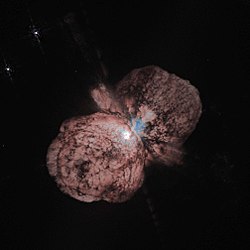Eta Carinae
 Der er for få eller ingen kildehenvisninger i denne artikel, hvilket er et problem. Du kan hjælpe ved at angive troværdige kilder til de påstande, som fremføres i artiklen.
Der er for få eller ingen kildehenvisninger i denne artikel, hvilket er et problem. Du kan hjælpe ved at angive troværdige kilder til de påstande, som fremføres i artiklen.

Eta Carinae er en ekstrem superkæmpe, der har en anslået masse på 100-150 gange Solens, hvilket medfører, at den udstråler omkring 4 millioner gange så megen energi som Solen. Eta Carinae er 7.500 til 8.000 lysår fra Solen og har en mindre, men dog meget stor ledsagestjerne.
Eta car, som den hedder i fagsproget, har den største masse af de stjerner som vi kan udforske i relativt stor detalje. Vi kender større stjerner, men vores viden om disse er begrænset i forhold til kendskabet om Eta Carinae.
Eta Carinae kan ses i stjernebilledet Carina (Kølen), der dog ikke er synligt fra Danmark, eftersom det er for langt mod syd på den sydlige himmelhalvkugle.
Eta Carinaes fortid
Omkring dobbeltstjernen ses to stjernetåger.
Den inderste stjernetåge, Homunculus-tågen, rækker 1 lysår ud fra dobbeltstjernen og er resterne af et superudbrud mellem 1837 og 1856, der gjorde Eta Carinae til en af den sydlige himmels kraftigste stjerner.
Den yderste stjernetåge rækker 2 lysår ud fra dobbeltstjernen og er resterne af et udbrud for ca. 1000 år siden.
Eta Carinaes fremtid
Eta Carinae har så stor masse, at den formodentlig vil ende sine dage som en såkaldt hypernova i en eksplosion, der er henimod 100 gange så kraftig end en supernova. Når dette sker, vil de store mængder materiale, supernovaen kaster ud (den såkaldte supernovarest, på adskillige solmasser), blandes med det interstellare medium (ISM), hvor det indgår i nye stjerner, som senere vil blive født, mens dens kerne vil falde sammen til et sort hul.
Eksterne links
- 3D-model afslører stjernernes fortid. Videnskab.dk Arkiveret 30. juni 2015 hos Wayback Machine
- ESO: Fantastiske Eta Carinae i høj opløsning Arkiveret 17. september 2017 hos Wayback Machine inklusive fotos og animation
| Wikimedia Commons har medier relateret til: |
|
Medier brugt på denne side
A huge, billowing pair of gas and dust clouds are captured in this stunning NASA Hubble Space Telescope image of the supermassive star Eta Carinae. Eta Carinae was observed by Hubble in September 1995 with the Wide Field and Planetary Camera 2 (WFPC2). Images taken through red and near-ultraviolet filters were subsequently combined to produce the color image shown. A sequence of eight exposures was necessary to cover the object's huge dynamic range: the outer ejecta blobs are 100,000 times fainter than the brilliant central star. Eta Carinae suffered a giant outburst about 160 years ago, when it became one of the brightest stars in the southern sky. Though the star released as much visible light as a supernova explosion, it survived the outburst. The explosion produced two lobes and a large, thin equatorial disk, all moving outward at about 1 million kilometers per hour.
(NASA News Release) A huge, billowing pair of gas and dust clouds are captured in this stunning NASA Hubble Space Telescope image of the supermassive star Eta Carinae.
Using a combination of image processing techniques (dithering, subsampling and deconvolution), astronomers created one of the highest resolution images of an extended object ever produced by Hubble Space Telescope. The resulting picture reveals astonishing detail.
Even though Eta Carinae is more than 8,000 light-years away, structures only 10 billion miles across (0.0017 LY, or about the diameter of our solar system) can be distinguished. Dust lanes, tiny condensations, and strange radial streaks all appear with unprecedented clarity.
Eta Carinae was observed by Hubble in September 1995 with the Wide Field Planetary Camera 2 (WFPC2). Images taken through red and near-ultraviolet filters were subsequently combined to produce the color image shown. A sequence of eight exposures was necessary to cover the object's huge dynamic range: the outer ejecta blobs are 100,000 times fainter than the brilliant central star.
Eta Carinae was the site of a giant outburst about 150 years ago, when it became one of the brightest stars in the southern sky. Though the star released as much visible light as a supernova explosion, it survived the outburst. Somehow, the explosion produced two polar lobes and a large thin equatorial disk, all moving outward at about 1.5 million miles per hour.
The new observation shows that excess violet light escapes along the equatorial plane between the bipolar lobes. Apparently there is relatively little dusty debris between the lobes down by the star; most of the blue light is able to escape. The lobes, on the other hand, contain large amounts of dust which preferentially absorb blue light, causing the lobes to appear reddish.
Estimated to be 100 times more massive than our Sun, Eta Carinae may be one of the most massive stars in our Galaxy. It radiates about five million times more power than our Sun. The star remains one of the great mysteries of stellar astronomy, and the new Hubble images raise further puzzles. Eventually, this star's outburst may provide unique clues to other, more modest stellar bipolar explosions and to hydrodynamic flows from stars in general.Chandra has revealed unexpected structures around the nova at the center of Eta Carina. The colors are artificial to help the viewer sort out details and structure. The new X-ray observation shows three distinct structures: an outer, horseshoe-shaped ring about 2 light years in diameter, a hot inner core about 3 light-months in diameter, and a hot central source less than 1 light-month in diameter which may contain the superstar that drives the whole show. The outer ring provides evidence of another large explosion that occurred over 1,000 years ago. Credit: Chandra Science Center and NASA.





